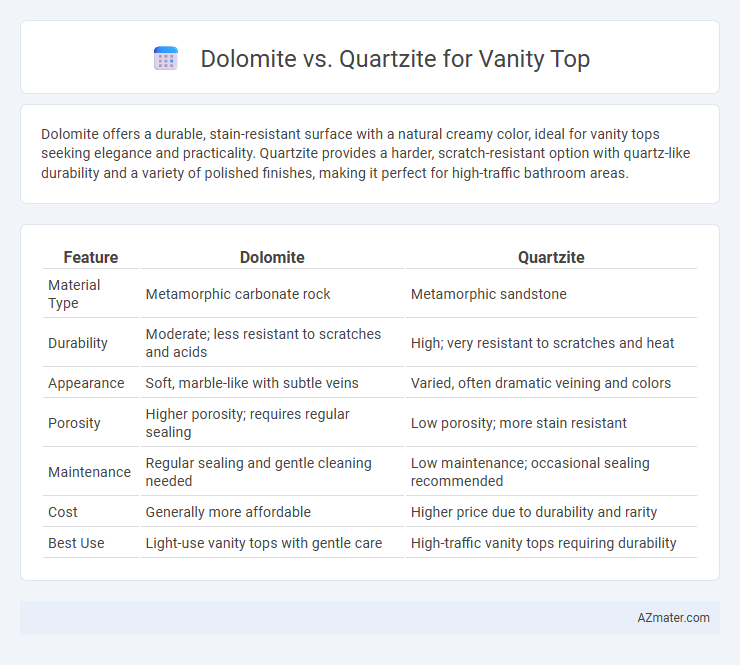Dolomite offers a durable, stain-resistant surface with a natural creamy color, ideal for vanity tops seeking elegance and practicality. Quartzite provides a harder, scratch-resistant option with quartz-like durability and a variety of polished finishes, making it perfect for high-traffic bathroom areas.
Table of Comparison
| Feature | Dolomite | Quartzite |
|---|---|---|
| Material Type | Metamorphic carbonate rock | Metamorphic sandstone |
| Durability | Moderate; less resistant to scratches and acids | High; very resistant to scratches and heat |
| Appearance | Soft, marble-like with subtle veins | Varied, often dramatic veining and colors |
| Porosity | Higher porosity; requires regular sealing | Low porosity; more stain resistant |
| Maintenance | Regular sealing and gentle cleaning needed | Low maintenance; occasional sealing recommended |
| Cost | Generally more affordable | Higher price due to durability and rarity |
| Best Use | Light-use vanity tops with gentle care | High-traffic vanity tops requiring durability |
Introduction: Comparing Dolomite and Quartzite for Vanity Tops
Dolomite and quartzite are popular natural stone choices for vanity tops, prized for their durability and aesthetic appeal. Dolomite, composed primarily of calcium magnesium carbonate, offers a smooth, elegant surface with moderate hardness and resistance to etching. Quartzite, formed from sandstone and metamorphosed quartz, is exceptionally hard and resistant to scratches and heat, making it ideal for high-use bathroom countertops.
Composition and Formation of Dolomite vs Quartzite
Dolomite is a sedimentary carbonate rock primarily composed of the mineral dolomite (calcium magnesium carbonate), formed through the diagenesis of limestone when magnesium-rich fluids alter calcite. Quartzite is a metamorphic rock consisting predominantly of interlocking quartz grains, created by the recrystallization of sandstone under intense heat and pressure. The distinct formation processes result in dolomite having a crystalline texture with chemical stability, while quartzite exhibits exceptional hardness and resistance due to its tightly fused quartz crystals.
Visual Appeal: Color and Pattern Differences
Dolomite vanity tops offer subtle color variations with soft, often white to gray hues featuring gentle veining that creates an understated elegance, making them ideal for classic or minimalist bathroom designs. Quartzite provides a wider spectrum of vibrant colors, from whites and greys to blues and greens, with striking, bold veining patterns that enhance visual drama and luxury appeal. The choice between dolomite and quartzite ultimately depends on whether a muted, refined look or a dynamic, eye-catching surface is desired for the vanity top.
Durability and Hardness: Which Material Lasts Longer?
Dolomite offers moderate hardness with a Mohs rating of 3.5 to 4, making it resistant to scratches and suitable for vanity tops with regular use, but it is more prone to etching from acids compared to quartzite. Quartzite rates higher on the Mohs scale, typically between 7 and 8, providing superior durability and resistance to scratches, heat, and etching, which ensures a longer lifespan for vanity countertops in high-traffic bathrooms. The enhanced hardness and resilience of quartzite make it a preferred choice for those seeking a more durable and low-maintenance surface than dolomite.
Maintenance Needs for Dolomite and Quartzite Vanity Tops
Dolomite vanity tops require regular sealing to prevent staining and etching due to their slightly softer and more porous nature compared to quartzite. Quartzite surfaces are highly durable and generally need less frequent sealing, offering superior resistance to scratches and heat, which simplifies maintenance. Proper cleaning with pH-neutral products ensures longevity and preserves the natural beauty of both dolomite and quartzite vanity tops.
Stain and Scratch Resistance Comparison
Dolomite offers moderate stain resistance but is more prone to scratching compared to quartzite, which excels in both stain and scratch resistance due to its dense, hard mineral composition. Quartzite's high quartz content makes it less susceptible to etching from acidic substances and daily wear, ideal for durable vanity tops. Choosing quartzite ensures longer-lasting surface integrity and easier maintenance in bathroom environments.
Cost Analysis: Price Differences Between Dolomite and Quartzite
Dolomite vanity tops generally cost less than quartzite, with prices ranging from $40 to $70 per square foot compared to quartzite's $70 to $150 per square foot. The price difference is influenced by factors such as rarity, durability, and installation complexity, with quartzite commanding a premium due to its hardness and resistance to scratching. Homeowners seeking budget-friendly options often prefer dolomite for its affordability while maintaining a natural stone aesthetic.
Installation Considerations and Challenges
Dolomite vanity tops require careful sealing during installation to prevent moisture penetration due to their porous nature, which can lead to staining and damage over time. Quartzite, being denser and harder, demands specialized diamond-tipped tools for cutting and shaping, increasing labor time and installation costs. Both materials need precise leveling and support to avoid cracking, but quartzite's superior durability offers better long-term resilience in high-use bathroom environments.
Environmental Impact and Sustainability
Dolomite is a naturally abundant mineral that requires less intensive quarrying processes, resulting in a lower environmental impact compared to quartzite, which often involves energy-intensive extraction and processing. Quartzite's hardness and resistance make it highly durable, reducing the need for frequent replacements and contributing to long-term sustainability in vanity tops. Choosing dolomite supports sustainable sourcing due to its availability and reduced carbon footprint throughout the supply chain, whereas quartzite's durability benefits sustainability by extending the lifespan of vanity surfaces.
Pros and Cons: Choosing the Right Vanity Top Material
Dolomite offers a natural marble-like appearance with good resistance to heat and moderate durability, making it an affordable option for vanity tops, but its susceptibility to scratches and acids requires regular sealing. Quartzite provides superior hardness and scratch resistance, as well as excellent heat and acid tolerance, ensuring long-lasting beauty and minimal maintenance for bathroom vanity surfaces. Choosing between dolomite and quartzite depends on balancing budget constraints with the desire for durability and ease of upkeep in a high-moisture environment.

Infographic: Dolomite vs Quartzite for Vanity Top
 azmater.com
azmater.com